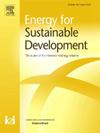Enhancing performance of operational utility-scale solar PV projects in India through re-powering: Potential and techno-economic assessment
IF 4.4
2区 工程技术
Q2 ENERGY & FUELS
引用次数: 0
Abstract
India is actively working towards achieving a Net Zero and decarbonization target by enhancing the adoption of renewable energy (RE) technologies (mainly solar and wind), notably solar and wind energy. The nation's Nationally Determined Contribution (NDC) targets a 45% reduction in the emissions intensity of its GDP by 2030 from the 2005 level. Additionally, the target for cumulative installed non-fossil fuel-based electric power capacity has been raised to 50 % by 2030. The solar power sector is the most significant contributor in achieving these targets.
As of February 2024, the total installed capacity of utility-scale solar power in India has surpassed 64 GW, constituting approximately 15% of the country's total installed capacity of 441 GW. Despite this, solar power only contributes around 5% to the overall energy mix. There are several operational limitations with solar projects viz. intermittency, seasonal availability, micro-climatic impacts, and operational & maintenance (O&M) issues, etc. Such projects offer an excellent opportunity for re-powering to tackle the issue of low performance and optimum use of resources (land, evacuation infrastructure, etc.) and enhance energy generation.
The objective of this paper is to evaluate the techno-economic potential for re-powering of utility-scale solar PV projects in India. The study indicates that the combined capacity for re-powering solar projects within the maximum thresholds of Power Purchase Agreements is 5.33 GWp. However, this capacity could be expanded to 9.6 GWp if the technical limitations are addressed. Repowering projects up to PPA limits could reduce emissions by 5.5 million tCO2/MWh to 10 million tCO2/MWh annually. According to the techno-economic assessment, repowered energy is the cheapest RE in India, with a Levelized Cost of Electricity (LCOE) of INR 1.45/kWh. However, specific policies and regulations for repowering solar PV projects in India are required to benefit project developers, attract investments, and optimize power evacuation infrastructure.
通过再发电提高印度公用事业规模太阳能光伏发电项目的绩效:潜力和技术经济评估
印度正通过加强采用可再生能源(RE)技术(主要是太阳能和风能),特别是太阳能和风能,积极努力实现净零排放和去碳化目标。印度的 "国家自主贡献"(NDC)目标是到 2030 年将其国内生产总值(GDP)的排放强度在 2005 年的基础上降低 45%。此外,到 2030 年,非化石燃料电力累计装机容量的目标已提高到 50%。截至 2024 年 2 月,印度公用事业规模太阳能发电的总装机容量已超过 64 千兆瓦,约占全国总装机容量 441 千兆瓦的 15%。尽管如此,太阳能发电仅占整个能源结构的 5%左右。太阳能项目在运营方面存在一些限制,如间歇性、季节性可用性、微气候影响以及运营和维护(O&M)问题等。本文旨在评估印度公用事业级太阳能光伏发电项目再发电的技术经济潜力。研究表明,在购电协议的最大阈值范围内,太阳能项目的再发电能力合计为 5.33 GWp。然而,如果技术限制问题得到解决,这一容量可扩大到 9.6 GWp。在《购电协议》限制范围内重新发电的项目每年可减少 550 万吨二氧化碳/兆瓦时至 1,000 万吨二氧化碳/兆瓦时的排放量。根据技术经济评估,再发电是印度最便宜的可再生能源,其平准化电力成本(LCOE)为 1.45 印度卢比/千瓦时。然而,印度需要针对太阳能光伏发电项目再发电的具体政策和法规,以惠及项目开发商、吸引投资并优化电力输送基础设施。
本文章由计算机程序翻译,如有差异,请以英文原文为准。
求助全文
约1分钟内获得全文
求助全文
来源期刊

Energy for Sustainable Development
ENERGY & FUELS-ENERGY & FUELS
CiteScore
8.10
自引率
9.10%
发文量
187
审稿时长
6-12 weeks
期刊介绍:
Published on behalf of the International Energy Initiative, Energy for Sustainable Development is the journal for decision makers, managers, consultants, policy makers, planners and researchers in both government and non-government organizations. It publishes original research and reviews about energy in developing countries, sustainable development, energy resources, technologies, policies and interactions.
 求助内容:
求助内容: 应助结果提醒方式:
应助结果提醒方式:


